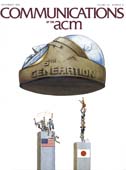September 1983 - Vol. 26 No. 9

Features
From Washington: Secrecy versus scientific communication
Programming pearls: Aha algorithms
Introduction to the fifth generation
The Japanese approach: a better way to manage programmers?
The fifth generation project — a trip report
Cooperation is key: an interview with B. R. Inman
A simple database language for personal computers
A practical tool kit for making portable compilers
An empirical study of insertion and deletion in binary search trees
Optimal paths in graphs with stochastic or multidimensional weights
A diagnosis of beginning programmers’ misconceptions of BASIC programming statements
A quadtree medial axis transform



